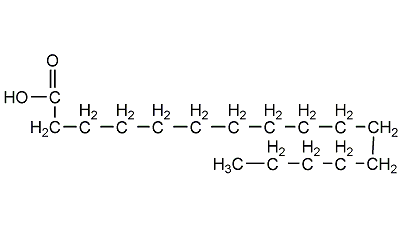
Structural formula
| Business number | 01JD |
|---|---|
| Molecular formula | C4H10 |
| Molecular weight | 58.12 |
| label |
2-Methylpropane, Trimethylmethane, Trimethylmethane, 2-Methylpropane, Aliphatic hydrocarbons |
Numbering system
CAS number:75-28-5
MDL number:MFCD00008926
EINECS number:200-857-2
RTECS number:TZ4300000
BRN number:1730720
PubChem ID:None
Physical property data
1. Properties: colorless, slightly odorous gas. [1]
2. Melting point (?): -159.6[2]
3. Boiling point (?): -11.8[3]
4. Relative density (water=1): 0.56 (20?)[4]
5. Relative vapor density (air=1): 2.01[5]
6. Saturated vapor pressure (kPa): 304 (20?)[6]
7. Heat of combustion (kJ/mol): -2871.1[7]
8. Critical temperature (?): 134.69[8]
9. Critical pressure (MPa): 3.65[9]
10. Octanol/water partition coefficient :2.76[10]
11. Flash point (?): -82.8[11]
12. Ignition Temperature (?): 460[12]
13. Explosion limit (%): 8.5[13]
14 .Lower explosion limit (%): 1.4[14]
15. Solubility: Slightly soluble in water, soluble in ether, ethanol, and chloroform. [15]
16. Lennard-Jones parameter (A): 5.5342
17. Lennard-Jones parameter (K): 274.84
18. Solubility parameter (J·cm-3)0.5: 14.027
19. van der Waals area (cm 2·mol-1): 6.930×109
20. van der Waals volume (cm3 sup>·mol-1): 47.790
21. Critical volume (cm3·mol-1): 259
22. Critical density (g·cm-3): 0.224
23. Critical compression factor: 0.278
24 .Eccentricity factor: 0.177
25. Gas phase standard combustion heat (enthalpy) (kJ·mol-1): -2868.2
26. Gas phase standard claim Heat (enthalpy) (kJ·mol-1): -135.0
27. Gas phase standard entropy (J·mol-1·K-1): 295.50
28. Gas phase standard free energy of formation (kJ·mol-1): -21.4
29. Gas phase standard hot melt (J·mol-1·K-1): 96.65
30. Liquid phase standard combustion heat (enthalpy) (kJ ·mol-1): -2848.9
31. Liquid phase standard claims heat (enthalpy) (kJ·mol-1): -154.3
32. Liquid phase standard entropy (J·mol-1·K-1): 217.94
33. Liquid phase Standard free energy of formation (kJ·mol-1): -17.8
34. Liquid phase standard hot melt (J·mol-1·K -1)?141.64
Toxicological data
1. Acute toxicity: rat inhalation LC50: 57 pph/15M; mouse inhalation LC50: 1041 gm/m3/2H;
Ecological data
1. EcotoxicityNo information available
2. Biodegradability No information available
3. Non-biodegradability[16] In the air, when the concentration of hydroxyl radicals is 5.00×105/cm3, the degradation half-life is 6.9d (theoretical).
4. Other harmful effects [17] This substance may be harmful to the environment. Special attention should be paid to surface water, soil, atmosphere and drinking water. of pollution.
Molecular structure data
1. Molar refractive index: 20.53
2. Molar volume (cm3/mol): 94.9
3. Isotonic specific volume (90.2K ): 188.6
4. Surface tension (dyne/cm): 15.5
5. Dielectric constant (F/m): 1.77
6. Polar Chemical rate (10-24cm3): 8.14
Compute chemical data
1. Reference value for hydrophobic parameter calculation (XlogP): 2.1
2. Number of hydrogen bond donors: 0
3. Number of hydrogen bond acceptors: 0
4. Number of rotatable chemical bonds: 0
5. Number of tautomers: none
6. Topological molecule polar surface area 0
7. Number of heavy atoms: 4
8. Surface charge: 0
9. Complexity: 4.8
10. Number of isotope atoms: 0
11. Determine the number of atomic stereocenters: 0
12. Uncertain number of atomic stereocenters: 0
13. Determine the number of chemical bond stereocenters: 0
14. Number of uncertain chemical bond stereocenters: 0
15. Number of covalent bond units: 1
Properties and stability
1. Stability[18] Stable
2. Incompatible substances[19] Strong oxidants, strong acids, strong bases, halogens
3. Polymerization hazards[20] No polymerization
Storage method
Storage Precautions[21] Stored in a cool, ventilated warehouse dedicated to flammable gases. Keep away from fire and heat sources. The storage temperature should not exceed 30?. should be kept away from oxidizer, do not store together. Use explosion-proof lighting and ventilation facilities. It is prohibited to use mechanical equipment and tools that are prone to sparks. The storage area should be equipped with leakage emergency response equipment.
Synthesis method
1. Exists in petroleum gas, natural gas and cracked gas. It is obtained by separating the carbon four fractions produced during the petroleum cracking process.
2. Use industrial isobutane as raw material (content is 82% to 91%), and adopt a three-stage adsorption process. The first-stage adsorber removes impurities such as C2, C3, n-butane and 1-butene, the second-stage adsorber removes isobutylene, and the third-stage adsorber further removes C2 and C3 hydrocarbon impurities. The product purity is greater than 99.99%.
Purpose
1. Used to produce isooctane through alkylation with isobutylene and used as a gasoline octane number improver. Isobutylene and propylene can be produced through cracking. Alkylation with isobutylene and propylene can produce alkylated gasoline. Methacrylic acid, acetone and methanol can be prepared. It can also be used as a refrigerant.
2. High-purity isobutane is mainly used as standard gas and for preparing special standard mixed gas.
3. Used to synthesize isooctane, as a gasoline octane number improver, used to make isobutylene, propylene, methacrylic acid, and used as refrigerant, etc. [22]
extended-reading:https://www.cyclohexylamine.net/polyurethane-catalyst-sa102-catalyst-sa102/extended-reading:https://www.newtopchem.com/archives/39599extended-reading:https://www.newtopchem.com/archives/44101extended-reading:https://www.newtopchem.com/archives/644extended-reading:https://www.bdmaee.net/dabco-pt304-polyurethane-rigid-foam-trimer-catalyst-pt304-polyurethane-trimer-catalyst-pt304/extended-reading:https://www.bdmaee.net/pc-cat-dmcha-catalyst/extended-reading:https://www.newtopchem.com/archives/40401extended-reading:https://www.bdmaee.net/dabco-t-45l-catalyst-cas121-143-5-evonik-germany/extended-reading:https://www.bdmaee.net/cas%ef%bc%9a-2969-81-5/extended-reading:https://www.bdmaee.net/jeffcat-td-20-catalyst-cas107-16-9-huntsman/



